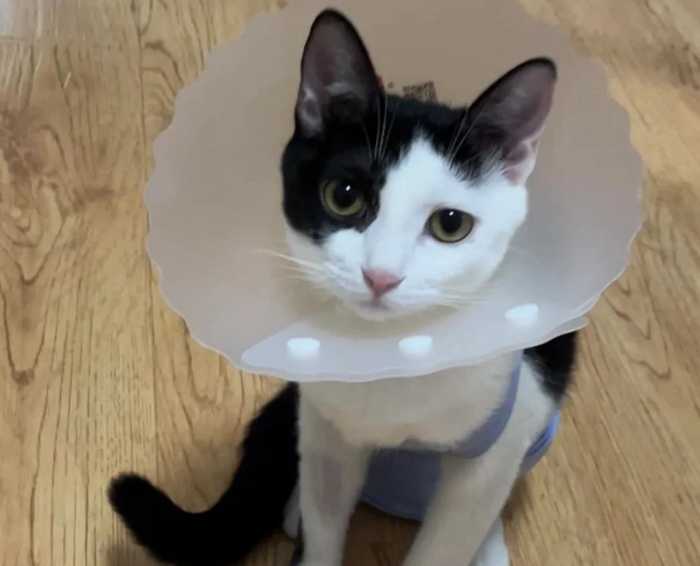Spaying is a common and important procedure for female cats, providing numerous health benefits and helping to control the pet population. However, post-operative care is crucial for ensuring a smooth recovery. One of the most common concerns for cat owners is what to do if their cat licks its surgical wound. This guide will explore effective strategies and tips for managing this situation, ensuring your feline friend heals properly.

1. Understanding the Importance of Post-Spaying Care
Why Proper Care is Essential After Spaying
After a cat undergoes spaying, proper care is vital to ensure a successful recovery. The surgery involves making an incision in the abdomen, and proper healing is necessary to prevent infections and complications. Cats may instinctively lick their wounds due to discomfort or irritation, which can lead to:
- Infection: Licking can introduce bacteria into the incision site.
- Delayed Healing: Excessive licking can disrupt the healing process.
- Wound Opening: In severe cases, licking can lead to the incision opening up.
Understanding the potential risks associated with licking is the first step in addressing this behavior.
2. Recognizing Signs of Discomfort
How to Identify If Your Cat Is in Pain
Cats are often masters at hiding pain, but there are signs you can look for to determine if your cat is uncomfortable after surgery:
- Vocalization: Increased meowing or vocalization can indicate discomfort.
- Changes in Behavior: Your cat may become more withdrawn or aggressive.
- Physical Signs: Look for signs such as a hunched posture, reluctance to move, or excessive grooming in the area of the incision.
Recognizing these signs can help you address any discomfort your cat may be experiencing, reducing the likelihood of licking.
3. Preventing Licking: The Use of Elizabethan Collars
Why an Elizabethan Collar is Effective
One of the most common methods to prevent cats from licking their wounds is the use of an Elizabethan collar (E-collar). Here’s why it can be beneficial:
- Barrier Against Licking: The collar prevents your cat from reaching its incision site, minimizing the risk of licking.
- Comfortable Fit: E-collars come in various sizes and can be adjusted for a comfortable fit.
- Visibility of Wound: The collar allows you to monitor the wound without interference.
Make sure to introduce the collar gradually, allowing your cat to adjust to it.
4. Alternative Options: Surgical Recovery Suits
Exploring Recovery Suits as an Alternative to E-Collars
Surgical recovery suits are becoming increasingly popular as an alternative to E-collars. These suits provide a snug fit that covers the incision site while allowing more freedom of movement. Benefits include:
- Comfort: Many cats find recovery suits more comfortable than traditional collars.
- Less Stress: Suits can reduce stress for some cats, as they allow for natural movements.
- Prevention of Licking: The suit provides a barrier against licking, similar to an E-collar.
Discuss with your veterinarian whether a recovery suit might be suitable for your cat.
5. Distraction Techniques to Reduce Licking
How to Distract Your Cat from Licking Its Wound
Keeping your cat occupied can help minimize licking. Here are some effective distraction techniques:
- Interactive Toys: Provide toys that encourage mental and physical engagement.
- Playtime: Spend extra time playing with your cat to divert its attention from the incision site.
- Puzzle Feeders: Use puzzle feeders to keep your cat engaged during meal times.
A stimulated cat is less likely to focus on its wound, reducing the risk of licking.
6. Monitoring the Surgical Site
How to Properly Check Your Cat’s Incision
Regularly monitoring your cat’s incision site is crucial for early detection of any issues. Here’s how to do it safely:
- Visual Checks: Carefully inspect the incision for redness, swelling, or discharge.
- Gentle Touch: If your cat allows it, gently touch around the incision to check for signs of pain.
- Note Any Changes: Keep track of any changes in the incision or your cat’s behavior and report them to your vet.
Maintaining vigilance can help catch any problems early.
7. Using Topical Treatments Wisely
When and How to Use Topical Treatments
In some cases, veterinarians may recommend topical treatments to soothe the incision area. Here’s how to use them appropriately:
- Consult Your Vet: Always consult your veterinarian before applying any treatments to ensure they are safe for post-surgical use.
- Application: Apply treatments according to your vet’s instructions, ensuring not to apply anything that might irritate the skin further.
- Monitor Reactions: After applying a topical treatment, observe your cat for any adverse reactions or increased licking.
Topical treatments can provide relief and promote healing when used correctly.
8. Importance of Follow-Up Veterinary Visits
Why Follow-Up Care is Crucial After Spaying
Post-surgery follow-ups are essential to ensure your cat is healing properly. During these visits, your vet can:
- Examine the Incision: Check for any signs of infection or complications.
- Adjust Medications: Modify pain management or prescribe additional treatments if needed.
- Answer Your Questions: Provide guidance on caring for your cat during recovery.
Regular follow-ups ensure your cat receives the best possible care during its recovery.
9. Providing Comfort During Recovery
How to Make Your Cat Comfortable Post-Surgery
Creating a comfortable environment can significantly aid your cat’s recovery. Consider the following tips:
- Quiet Space: Provide a quiet, cozy area where your cat can rest undisturbed.
- Soft Bedding: Use soft, clean bedding to make your cat’s recovery area inviting.
- Reduce Stressors: Minimize loud noises and other stressors in the home during recovery.
A comfortable environment promotes healing and reduces anxiety.
10. Conclusion: Ensuring a Smooth Recovery for Your Cat
After spaying, it’s essential to take proactive steps to prevent your cat from licking its wound. By using E-collars or recovery suits, monitoring the incision, and providing distractions, you can help your cat heal comfortably and quickly. Always consult your veterinarian for personalized advice and support during your cat’s recovery journey.

Comments (0)